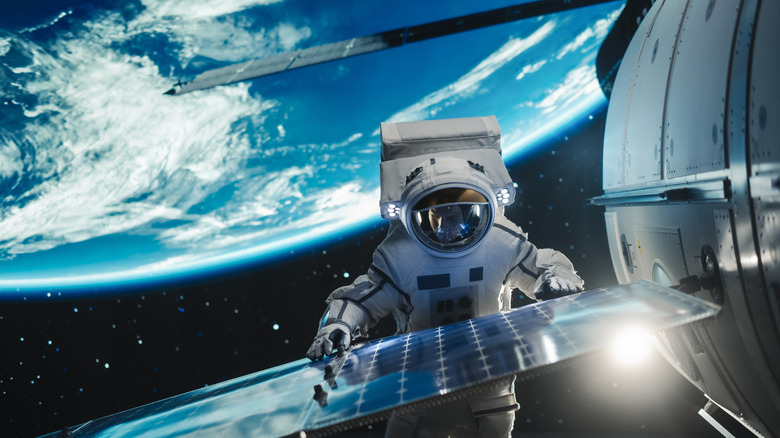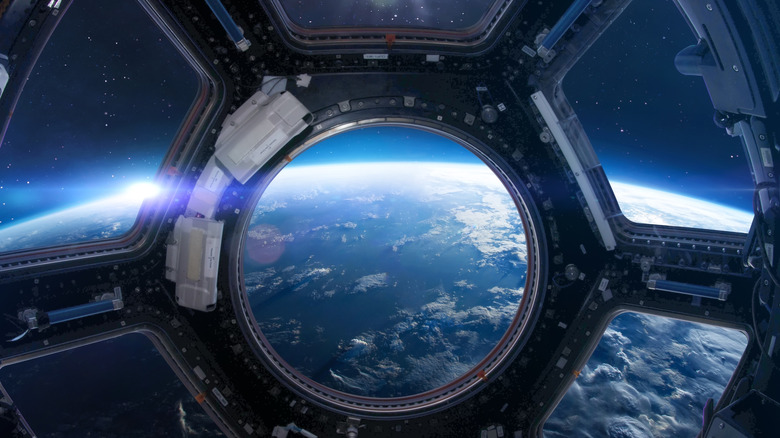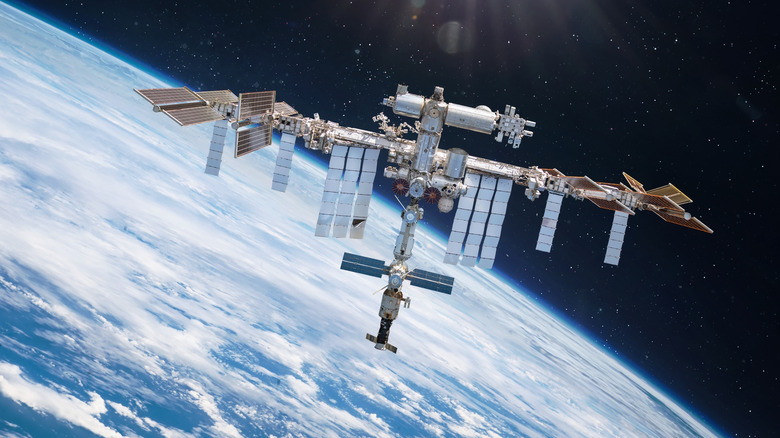If You Thought Astronauts Don't Experience Gravity, You'd Be Dead Wrong
One of the cooler aspects of being an astronaut is the ability to float around in the weightlessness of space. When you think about the daily lives of the scientists aboard various spacecraft circling the globe, you're probably imagining them moving about in total freedom from the pull of gravity (well, at least when you're not wondering about the things astronauts are banned from doing onboard the International Space Station). But the truth is, astronauts don't operate in zero gravity; they actually live in microgravity — a state when gravity is still very much present, just not like it is on Earth. This fundamental misconception stems from the way gravity and motion interact in orbit, creating the illusion of a gravity-free environment (Hollywood certainly hasn't helped things, either).
The misunderstanding about gravity for astronauts persists because we often equate weightlessness with a total absence of gravity. In reality, gravity on the ISS is about 90% of what we experience on Earth. That's because the station is orbiting our planet at a distance of roughly 200 to 250 miles. So, why do astronauts float? It all comes down to the concept of free fall. The ISS, along with everyone inside it, is continuously falling toward Earth. However, it's moving so rapidly (a phenomenal 17,500 miles per hour, mind you) that it essentially "falls around" the planet rather than straight down.
Understanding this distinction is crucial, especially when planning space missions and studying how the human body adapts to space. It's why astronauts undergo extensive physical training and why scientists continuously research how to mitigate the long-term impacts of living in microgravity. Let's take a look at what life in microgravity looks like.
How microgravity affects the body
Living in microgravity sounds like a dream — floating effortlessly through space as you go about your day, free from the worries of falling down, dropping your phone, and wearing your joints down. But the reality for astronauts is far more challenging and complicated. In the absence of Earth's full gravitational pull as felt in the atmosphere, the human body undergoes dramatic changes. One of the most significant is muscle atrophy. On Earth, our muscles work against gravity to maintain posture and movement. In space, without that resistance, muscles (especially in the legs and back) quickly weaken. That's why astronauts spend 10 hours a week exercising on treadmills, stationary bikes, and resistance machines to mitigate muscle loss. Even then, they can continue to lose muscle mass.
Microgravity also affects bone density. Figures from NASA indicate that astronauts can lose 1%–1.5% of bone mass per month in space. This phenomenon occurs because, like the muscles, the bones in the body no longer bear the weight they would on Earth. Reduced mechanical stress leads to calcium loss, increasing the risk of fractures and early osteoporosis. Exercise helps counteract this bone loss, but NASA has also found that certain medications, including bisphosphonates, might help reduce the impact of bone loss in microgravity.
Then there is the issue of fluid distribution (not that one, although if you're interested, here is why using the bathroom on the ISS is more complicated than you think). On Earth, gravity pulls the body's fluids toward the lower extremities. In microgravity, fluids shift all over, usually upward, causing what some astronauts call "moon face." The increased pressure on the eyes can lead to problems with an astronaut's vision, and the strange pressures might even lead to an increased risk of dehydration or kidney stones.
Microgravity prep and the future of life in space
As humanity looks toward extended space missions — from a return to the Moon to eventual human expeditions to Mars — preparing astronauts for microgravity has become more relevant than ever. To combat muscle atrophy and bone density loss, space agencies are constantly innovating exercise regimens and equipment. For instance, the advanced Resistive Exercise Device aboard the International Space Station allows astronauts to perform squats and other exercises, mimicking the resistance they would experience on Earth.
Beyond physical health, scientists are grappling with the psychological impacts of microgravity, too. Studies have shown that the fluid shifts experienced in space lead to increased intracranial pressure, affecting mood and cognitive functions. With crewed missions to Mars estimated to take around 350 days one way, astronauts' mental well-being will be just as important as their physical fitness. Microgravity research also has practical applications here on Earth. The bone density loss experienced by astronauts offers insights into osteoporosis treatments, while fluid dynamics studies help to understand cardiovascular diseases.
In this way, preparing for life in microgravity advances both space exploration and medical breakthroughs on the ground. It's not all bad, though. The same lack of gravitational force that causes bones to grow weaker in space takes pressure off load-bearing systems like the spine. As a result, spines can elongate in space, leading to astronauts gaining as much as a 3% increase in height. As scientists continue to study how to keep astronauts healthy for long-term missions, it's clear that the more we learn about microgravity, the better prepared we'll be for that next giant leap in human space exploration. And if you thought astronauts didn't already have enough to put up with in space, here's a list of foods astronauts are banned from eating onboard the International Space Station.


